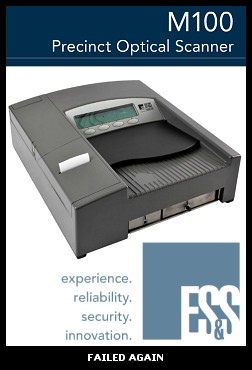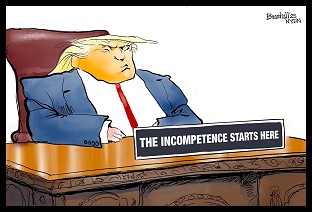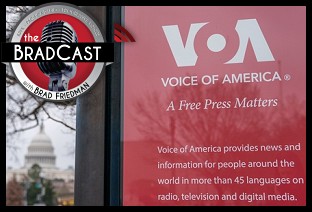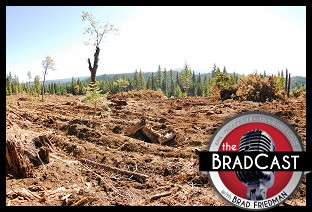By Ernest A. Canning and Brad Friedman
 We now have yet another ominous sign of trouble that may be on the horizon for this November's election. As if we needed yet another sign. And, once again, the concerns come via failures on paper ballot-based optical-scan computer tally systems.
We now have yet another ominous sign of trouble that may be on the horizon for this November's election. As if we needed yet another sign. And, once again, the concerns come via failures on paper ballot-based optical-scan computer tally systems.
Election officials in Genessee County, Michigan have acknowledged failures by the county's M-100 model optical-scan system, made by Election Systems and Software, Inc. (ES&S), during its Aug. 7 primary.
According to the county's Supervisor of Elections and Vital Records, Doreen D. Fulcher, the system experienced paper jams that resulted in ballots being fed through the system more than once. Fulcher, who also noted that there were a "number of ballots cast" that "didn't initially match poll book numbers," downplayed the scope of the problem. Flint's MLive, however, reported that the County Board of Canvassers were "still unraveling" the problem ten days after the election.
It is not the first time the M-100, set to be used in 32 different states again this November, has caused headaches for election officials and voters. The systems have a documented record of failing to count the same ballots the same way twice during pre-election testing. Nor is it the only optical-scan system made by ES&S, the largest e-voting vendor in the nation, that has failed time and again during elections.
As The BRAD BLOG previously reported, ballots obtained by the New York Daily News through a public records request revealed that ES&S op-scan systems used in a South Bronx precinct in 2010 failed to count some 70% of the paper ballots correctly in that year's primary election. In November's general election that year, some 54% of the ballots were mistallied at the same precinct.
The South Bronx used the newer ES&S model DS200, which the company confirmed could overheat, causing anywhere from 30% to 70% of the votes scanned by the machines to be erroneously discarded or erroneously counted. Thus, in the case of New York, that meant that tens of thousands of perfectly valid votes went uncounted, while thousands of "phantom votes" in races that voters hadn't intended to vote in at all were counted as valid.
The confirmation of the New York failure came almost two years after the election, once the newspaper was finally able to review the paper ballots by hand, under public records laws.
While Genessee County used the earlier ES&S Model M100, as we previously reported, the unreliability of opaque optical-scan computer tallying systems are, by no means, confined to the DS200 or, for that matter, to ES&S systems. Similar systems will once again be used across the entire country this November, to tally the Presidential election and all the races below it...either accurately or not...
Not Just the DS200 --- and Not Just ES&S' Systems
Back in 2008, The BRAD BLOG wrote about the M-100s when Oakland County, MI was seeking help from the U.S. Election Assistance Commission (EAC) concerning that particular precinct-based op-scanner, after pre-election tests of the system had "yielded different results each time" the "same ballots were run through the same machines."
According to the letter [PDF] sent to the EAC by Oakland County election officials at the time...
ES&S determined that the primary issue was dust and debris build-up on the sensors inside the M-100.
...
Unfortunately, [local clerks] are prohibited from performing any maintenance/cleaning on the machines as it voids the warranties. ES&S has not performed any preventative maintenance under the state contract, since the machines were delivered three years ago.
The ES&S M-100s, according to VerifiedVoting.org, are set for use this year by more than 31 million registered voters in more than 700 counties in 32 different states, including Alabama, Arkansas, Arizona, California, Colorado, Florida, Iowa, Idaho, Illinois, Indiana, Kansas, Kentucky, Maine, Michigan, Minnesota, Missouri, Mississippi, Montana, North Carolina, North Dakota, Nebraska, New Mexico, Ohio, Pennsylvania, South Dakota, Tennessee, Texas, Virginia, Washington, Wisconsin, West Virginia and Wyoming.
And while ES&S has a long and storied history of disastrous failures in U.S. elections across the country, with both its touch-screen and op-scan system, theirs are not the only optical-scan systems to produce flawed results and tallies that are not confirmed as accurate by anyone before they are announced to the world.
After the discovery in 2008 that Diebold's op-scan machines, like ES&S', were failing to tally ballots properly --- they were found to have actually been dropping the results from entire decks of ballots fed into the machines without notice to the system operator --- an investigation by California Sec. of State Debra Bowen (D) led to the admission by Diebold that their systems also failed to log events properly, allowing activity log files to be deleted entirely, without a trace of the system manipulation being left behind. That disastrous failure was found to have affected all of Diebold's voting systems, both touch-screen and optical-scan in use around the nation.
Many of those flawed systems, with gaping security holes, are still in use today. Diebold-manufactured electronic voting and tabulation systems are used in almost 1,500 voting jurisdictions in dozens of states by almost 50 million registered voters.
And, while many voters believe a paper ballot is all they need to assure that results will be accurately tabulated and reported --- versus touch-screen systems which are, indeed, 100% unverifiable --- they couldn't be more wrong. Need further proof? Keep in mind what happened earlier this year in Palm Beach County, FL.
As we initially reported in March, paper ballot op-scan systems there made by Sequoia Voting Systems produced inaccurate results in a number of races during a municipal election there.
The Sequoia computer tabulators named losing candidates as "winners" in several different races.
Fortunately, the failure was noticed by the local Supervisor of Elections when a post-election spot-check of 2% of the paper ballots (which is not done at all in many states) revealed that the races had been reported inaccurately by the Sequoia central tabulator system known as WinEDS.
A subsequent 100% hand-count of paper ballots was needed to accurately determine the actual winning candidates in those Palm Beach contests.
Dominion Voting, which now sells, services and programs Sequoia Voting Systems e-voting and tabulating systems, admitted that the programming flaw that caused the mistallied races exists in every version of their WinEDS software, though the company's President subsequently attempted to tell a differing story to state officials.
The Sequoia WinEDS system is currently in use in 285 jurisdictions in 17 states, where it's set to tally the votes --- either accurately or inaccurately --- for some 25 million registered voters this year in Arizona, California, Colorado, Florida, Idaho, Illinois, Louisiana, Michigan, Missouri, New Jersey, Oregon, Pennsylvania, Virginia and Wisconsin.
After the Sequoia system failures came to light in Palm Beach County --- along with Dominion/Sequoia's attempts at covering them up --- Susan Bucher, their Supervisor of Elections, told The BRAD BLOG that she'd be delighted to switch to a different system made by a different manufacturer, "but they all have similar problems, as I've come to understand it."
As we've noted previously, Bucher understands it correctly.
All computer voting systems have similar flaws that are often only revealed, if ever, via a hand-count of paper ballots. Unfortunately, very few jurisdictions in the U.S. are smart enough (and respectful of their voters enough) to count any of their ballots by hand at all.
To that end, a number of citizen organizations in Wisconsin have filed public records requests in all 72 of Wisconsin's counties in an effort to hand-count the paper ballots cast in the state's historic June 5th Gubernatorial recall election. Several counties in the Badger State, including the heavily Republican Waukesha County, use the same Sequoia WinEDS system that announced losing candidates to be the winners just months before in Palm Beach County, FL.
As we reported exclusively last weekend, according to the citizen auditors, that hand count effort has so far discovered that tallies "have differed, sometimes significantly, from the recorded numbers" reported on Election Night. They also say that, in the 10 counties they've hand-audited to date, the group is finding that "sometimes the numbers on the poll tapes" --- the machine result print-outs created after the close of polls by paper-ballot optical-scan computers as well as touch-screen devices, where they are used --- "do not match the numbers reported" by election officials on Election Night.
If the U.S. counted votes by hand in the first place --- publicly, on hand-marked paper ballots on Election Night, at the precinct, with results reported then and there, before ballots are moved anywhere, as per "Democracy's Gold Standard" --- confidence in reported election results might not continue to wane as it has over recent years. And, as we've explained before, in the bargain, the U.S. might one day become the "world's greatest democracy" that it has long pretended to be.


 Bad Court and Election News for Trump is Good News for America: 'BradCast' 3/31/25
Bad Court and Election News for Trump is Good News for America: 'BradCast' 3/31/25 Sunday 'Great Start!' Toons
Sunday 'Great Start!' Toons Vets Push Back at Trump, Musk Plan to Slash Health Care, 80K V.A. Jobs: 'BradCast' 3/27/25
Vets Push Back at Trump, Musk Plan to Slash Health Care, 80K V.A. Jobs: 'BradCast' 3/27/25 'Green News Report' 3/27/25
'Green News Report' 3/27/25
 Signal Scandal Worsens for Trump, GOP; Big Dem Election Wins in PA: 'BradCast' 3/26
Signal Scandal Worsens for Trump, GOP; Big Dem Election Wins in PA: 'BradCast' 3/26 'Emptywheel' on Why Trump NatSec Team Should 'Resign in Disgrace' After Signal Chat Debacle: 'BradCast' 3/25/25
'Emptywheel' on Why Trump NatSec Team Should 'Resign in Disgrace' After Signal Chat Debacle: 'BradCast' 3/25/25 'Green News Report' 3/25/25
'Green News Report' 3/25/25 USPS 'Belongs to the People, Not the Billionaires': 'BradCast' 3/24/25
USPS 'Belongs to the People, Not the Billionaires': 'BradCast' 3/24/25 Sunday 'Suddenly Conceivable' Toons
Sunday 'Suddenly Conceivable' Toons 'Green News Report' 3/20/25
'Green News Report' 3/20/25 We're ALL Voice of America Now: 'BradCast' 3/20/25
We're ALL Voice of America Now: 'BradCast' 3/20/25 What Trump's 'Timber Production Expansion' Means (and Costs): 'BradCast' 3/19/25
What Trump's 'Timber Production Expansion' Means (and Costs): 'BradCast' 3/19/25 Courts Largely Holding Against Trump, Musk Lawlessness: 'BradCast' 3/18/25
Courts Largely Holding Against Trump, Musk Lawlessness: 'BradCast' 3/18/25 Chief VOA Reporter on Outlet Falling Silent First Time Since 1942: 'BradCast' 3/17/25
Chief VOA Reporter on Outlet Falling Silent First Time Since 1942: 'BradCast' 3/17/25 Trump EPA Unveils Plans to Endanger, Sicken Americans: 'BradCast' 3/13/25
Trump EPA Unveils Plans to Endanger, Sicken Americans: 'BradCast' 3/13/25 Trump Nixed Enforce-ment Against 100 Corp. Lawbreakers: 'BradCast' 3/12/25
Trump Nixed Enforce-ment Against 100 Corp. Lawbreakers: 'BradCast' 3/12/25 Bad Day for 'Strongmen': 'BradCast' 3/11
Bad Day for 'Strongmen': 'BradCast' 3/11 WI Election Could Flip Supreme Court Control, Musk Jumps In: 'BradCast' 3/10
WI Election Could Flip Supreme Court Control, Musk Jumps In: 'BradCast' 3/10
 VA GOP VOTER REG FRAUDSTER OFF HOOK
VA GOP VOTER REG FRAUDSTER OFF HOOK Criminal GOP Voter Registration Fraud Probe Expanding in VA
Criminal GOP Voter Registration Fraud Probe Expanding in VA DOJ PROBE SOUGHT AFTER VA ARREST
DOJ PROBE SOUGHT AFTER VA ARREST Arrest in VA: GOP Voter Reg Scandal Widens
Arrest in VA: GOP Voter Reg Scandal Widens ALL TOGETHER: ROVE, SPROUL, KOCHS, RNC
ALL TOGETHER: ROVE, SPROUL, KOCHS, RNC LATimes: RNC's 'Fired' Sproul Working for Repubs in 'as Many as 30 States'
LATimes: RNC's 'Fired' Sproul Working for Repubs in 'as Many as 30 States' 'Fired' Sproul Group 'Cloned', Still Working for Republicans in At Least 10 States
'Fired' Sproul Group 'Cloned', Still Working for Republicans in At Least 10 States FINALLY: FOX ON GOP REG FRAUD SCANDAL
FINALLY: FOX ON GOP REG FRAUD SCANDAL COLORADO FOLLOWS FLORIDA WITH GOP CRIMINAL INVESTIGATION
COLORADO FOLLOWS FLORIDA WITH GOP CRIMINAL INVESTIGATION CRIMINAL PROBE LAUNCHED INTO GOP VOTER REGISTRATION FRAUD SCANDAL IN FL
CRIMINAL PROBE LAUNCHED INTO GOP VOTER REGISTRATION FRAUD SCANDAL IN FL Brad Breaks PA Photo ID & GOP Registration Fraud Scandal News on Hartmann TV
Brad Breaks PA Photo ID & GOP Registration Fraud Scandal News on Hartmann TV  CAUGHT ON TAPE: COORDINATED NATIONWIDE GOP VOTER REG SCAM
CAUGHT ON TAPE: COORDINATED NATIONWIDE GOP VOTER REG SCAM CRIMINAL ELECTION FRAUD COMPLAINT FILED AGAINST GOP 'FRAUD' FIRM
CRIMINAL ELECTION FRAUD COMPLAINT FILED AGAINST GOP 'FRAUD' FIRM RICK SCOTT GETS ROLLED IN GOP REGISTRATION FRAUD SCANDAL
RICK SCOTT GETS ROLLED IN GOP REGISTRATION FRAUD SCANDAL VIDEO: Brad Breaks GOP Reg Fraud Scandal on Hartmann TV
VIDEO: Brad Breaks GOP Reg Fraud Scandal on Hartmann TV RNC FIRES NATIONAL VOTER REGISTRATION FIRM FOR FRAUD
RNC FIRES NATIONAL VOTER REGISTRATION FIRM FOR FRAUD EXCLUSIVE: Intvw w/ FL Official Who First Discovered GOP Reg Fraud
EXCLUSIVE: Intvw w/ FL Official Who First Discovered GOP Reg Fraud GOP REGISTRATION FRAUD FOUND IN FL
GOP REGISTRATION FRAUD FOUND IN FL


































